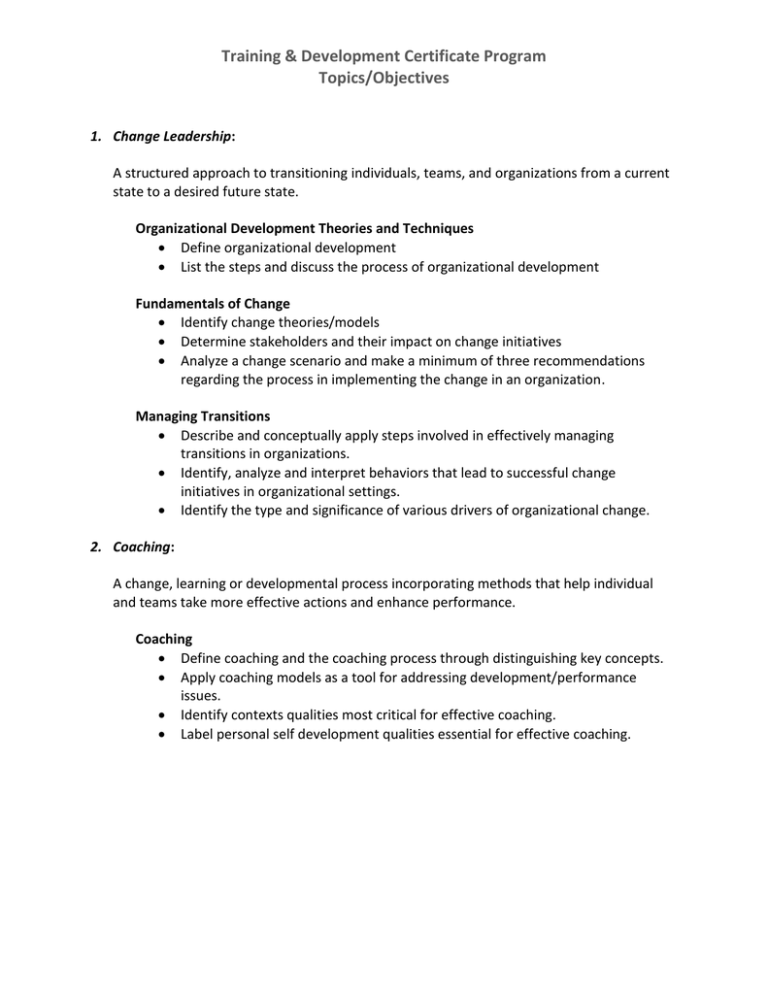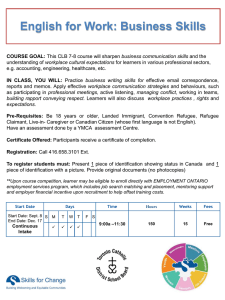Training & Development Certificate Program Topics/Objectives
advertisement

Training & Development Certificate Program Topics/Objectives 1. Change Leadership: A structured approach to transitioning individuals, teams, and organizations from a current state to a desired future state. Organizational Development Theories and Techniques Define organizational development List the steps and discuss the process of organizational development Fundamentals of Change Identify change theories/models Determine stakeholders and their impact on change initiatives Analyze a change scenario and make a minimum of three recommendations regarding the process in implementing the change in an organization. Managing Transitions Describe and conceptually apply steps involved in effectively managing transitions in organizations. Identify, analyze and interpret behaviors that lead to successful change initiatives in organizational settings. Identify the type and significance of various drivers of organizational change. 2. Coaching: A change, learning or developmental process incorporating methods that help individual and teams take more effective actions and enhance performance. Coaching Define coaching and the coaching process through distinguishing key concepts. Apply coaching models as a tool for addressing development/performance issues. Identify contexts qualities most critical for effective coaching. Label personal self development qualities essential for effective coaching. Training & Development Certificate Program Topics/Objectives 3. Communicating Effectively: Effective communication includes expressing thoughts, ideas and feelings in a concise manner in both individual and group situations. It means practicing focused listening and evoking responses through powerful questions. Effective communication targets conversations for collaboration and feedback exchange. This includes learning to observe body language during conversations and within group facilitation. Listening Distinguish key components of listening. Practice focused listening. Questioning Compare the effectiveness of different types of questions. Invite dialog using techniques that evoke insight and feedback. Feedback Differentiate between styles of feedback. Identify guidelines for two-way feedback in specific behavioral terms. Observing Define the three domains utilized in observing to gather information. Practice observation using the LEB model. Collaborative Conversations Discuss three components (emotions, contents and relationships) that impact collaborative conversations. Distinguish the three types of conversations (speculative, action, community building). Training & Development Certificate Program Topics/Objectives 4. Designing Learning: A systematic approach for designing, creating, and developing the learning event that will result in maximizing job performance. ADDIE Model Describe the ADDIE Instructional Design Model. Objectives Preparation Using an actual learning need, construct one objective that incorporates all components of a behavioral objective. Subject Matter Understanding Explain how subject matter experts relate to the implementation of the ADDIE model. Promoting Collaborative Learning Discuss strategies that engage learners and promote collaborative learning. Developing High Impact Training Materials Identify elements of high impact training materials. Design two high impact training materials for use in an actual learning event. For a selected topic, design a sequenced lesson that includes at least two behavioral objectives, a content outline, method(s) and materials for the lesson, and evaluation methods. 5. Developing and Applying Business Acumen: The ability to make profitable and quick business decisions. Trends and Issues in Business and Industry Explore the trends and issues facing business and industry today and apply strategies for linking learning with the bottom-line of the organization. Engage in strategic planning within the organization, to move knowledge acquisition from an operational role to a functional role; Align learning and performance with the mission, vision, values, and overall business strategy of the organization. Group Process Apply understanding of group dynamics to performance improvement initiatives. Utilize strategies to ensure full group participation in team decisions. Training & Development Certificate Program Topics/Objectives Delegating Define delegating and explain its benefits to the employee, the team, and the organization. Practice effective delegation using a 5-step model. Leading Explain the importance of the learning professional serving as a leader within the organization. Identify the Five Practices of Exemplary Leadership®. Understand the specific behaviors and actions that leaders use to get extraordinary things done within organizations. Use positive influence and modeling (rather than coercion or manipulation) to inspire others to achieve desired results. 6. Developing Partnerships: Develop and use a network of collaborative relationships with internal and external contacts to leverage the workplace learning and performance strategy in a way that facilitates the accomplishment of business results. Relationship Building Apply understanding of the importance of building relationships and maintaining long-lasting, collaborative connections with internal and external professionals to advance and enhance the value provided by workplace learning and performance. Explore the value of creating partnerships with others for sharing learning, knowledge, and opportunities. Employee Engagement Apply understanding of the importance of developing employees, creating action plans, and providing inspiration and guidance to achieve workplace goals. Model the ability to interact with others in a way that gives them confidence in one’s intentions and those of the organization. Demonstrate honesty and integrity and ensure that words and actions are congruent; (i.e., Walk your talk!). Training & Development Certificate Program Topics/Objectives 7. Ethics: A set of cognitive processes—feelings, concerns, rules, principles, virtues, values, and decision processes—that allow people to live and work together and successfully pursue their common and individual interests. Describe the current climate of business ethics in business, not-for-profit, and government organizations. Understand the difference between being personally ethical and effectively ethical in your workplace. Identify important steps in ethical decision-making in your own experience and apply them to an ethical situation you faced: Recognize an ethical issue o Understand how to point out ethical issues without creating defensiveness o Be able to move people from game frame (bottom line thinking only) to ethics (human) frame Make an ethical judgment (Trust the Force) o Recognize the patterns and where they come from o Understand the limitations of judgments Reflect on whether that judgment is valid (Use Your Head) o Understand the validity tests o Recognize the limitations of self-reflection Discuss whether the judgment is valid (Engage the Crowd) o Apply the validity tests o Recognize the limitations of discussion Choose how to act in the situation Recognize and evaluate standard excuses for unethical behavior. Recognize and know how to counter organizational features that pressure good individuals in ethical organizations to do bad things. Training & Development Certificate Program Topics/Objectives 8. Improving Human Performance: A results-based, systematic process used to identify performance problems, analyze root causes, and select workplace solutions to improve performance in an organization. State the purpose and goals of human performance improvement. Describe the differences in outcomes between performance improvement and training. List five factors that affect human performance in the workplace. Performance Analysis Describe how to use performance analysis to identify an organizational issue or need. Individual, Workplace, Team, and Organization Interventions Describe the relationship between systems thinking and performance improvement. Compare, contrast and apply four models/tools to analyze performance. Describe three tools for determining the root causes of performance issues and how they are used. Define categories of performance interventions (workplace solutions). Determine “best fit” performance interventions to be used for specific performance issues. 9. Managing the Learning Environment: The learning environment is key to the acquisition of new knowledge, skills, and attitudes. It incorporates learning theories and techniques as well as the physical and psychological components of the learning event. Training Techniques Learn creative training techniques their impact on learning. Learn methods to increase retention and their impact on learning Develop and present a nontraditional learning activity Adult Learning Identify unique characteristics of adult learners. Define various learning theories and styles Design a learning activity that addresses the needs of multiple learning styles. Training & Development Certificate Program Topics/Objectives Facilitation Skills Explain the similarities and differences in instructional and facilitation skills. Describe the five components of facilitation. Discuss facilitator competencies and principles. Explain effective presentation techniques for methods and media. Facilities (Physical Environment) Identify meeting locations and the advantages and disadvantages of each. Understand factors exterior to the facilities. Understand the facilities and logistical planning on learning. Determine ideal physical room space requirements. Select appropriate room and seating arrangement. 10. Measuring and Evaluating: The planned, systematic measurement and evaluation of workplace learning and performance programs and interventions for the purpose of continuously improving individual, group and organizational effectiveness. Evaluation Justify the reasons for the effective measurement and evaluation of learning and performance programs and interventions. Identify and discuss problems with learning and performance measurement and evaluation and ways to overcome these problems. Identify and describe the three components of effective measurement and evaluation planning; an evaluation framework, a data collection plan and a data analysis plan. Identify and describe the five levels of evaluation in the Phillips framework. Driving Results Defend how the effective measurement and evaluation of learning and performance programs and interventions drives business results. Using the value chain, or Phillips “V” diagram, describe how the levels of evaluation relate to and support the attainment of organizational goals and objectives Know where to look for additional information and resources. Training & Development Certificate Program Topics/Objectives 11. Self Understanding in the Workplace: Increased self understanding of one’s personal values, needs, interests, competencies and perceptions shapes decision-making and behavior in the workplace, and positively impacts the emotions and performance of others. Emotional Intelligence Define and describe emotional intelligence Discuss impact of emotional intelligence Select strategies to improve your emotional intelligence Intellectual Versatility Identify personal barriers to creativity and logical thinking. Recognize the benefits of exploring and reframing projects and problems to increase our effectiveness. Practice a problem solving method Self Awareness Identify individual behavioral styles. Define personal behavioral strengths and behavioral challenges. Determine other areas of self-knowledge and develop an action plan to gain additional self-knowledge. Career Development Identify career development stakeholders and responsibilities. Discuss career development for individuals and organizations. Create a career purpose poster. Training & Development Certificate Program Topics/Objectives 12. Talent Development: Talent Development increases an organization’s competitive advantage by: Collecting and managing organizational knowledge Attracting, developing and integrating new workers Developing and positioning current workers for moving up within the organization Assessing organizational needs Attracting highly skilled workers Managing organizational knowledge Understand the importance of managing knowledge in organizations Define the goals for knowledge management List knowledge management components Identify avenues for knowledge collection, storage, and transfer Talent management Define talent management Identify the components of a talent management system Discuss current applications of talent management strategies Succession planning Define succession planning and identify the difference between succession planning, transition planning, and replacement planning Detail the succession planning process and explain how needs assessment procedures, evaluation of employees, and individual employee development fit into the process Discuss how IDPs support career development and succession planning Create an IDP Leveraging diversity and generational differences Identify diversity issues in the workplace to include multi-cultural and multigenerational environments Discuss how gender, culture, and generational issues affect the learning and performance environment Identify strategies that can be used to facilitate improved organizational performance in diversity rich environments Managing the learning function (CLO) Identify the role of learning and development professionals in the talent development process Training & Development Certificate Program Topics/Objectives Apply appropriate talent development techniques to improve organizational performance (use a case study to give participants experience with applying techniques)








